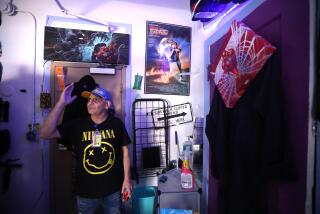San Bernardino group home ‘felt like a prison’
- Share via
SAN BERNARDINO — Shortly after moving into a group home here six months ago, Trevor Castro said, he began to feel less like a paying tenant and more like a prisoner.
The bleak compound was surrounded by a cinder-block wall topped with coils of jagged razor wire. He lived in a converted chicken coop with no plumbing and a bucket for a toilet. He said he was kicked, had a glass broken on his face by a staff member and had cans of cigarette butts dumped on him.
On Friday, police came looking for 23-year-old Castro for an outstanding DUI warrant and saw a bucket of urine outside his door.
“Once they started looking around, that was it,” he said as he and neighbors gathered outside the home Saturday.
The scale of the squalor, the smell, the filth and the reported abuse of the 22 elderly and mentally ill people living at the North Golden Avenue property led to the arrest of owner Pensri Sophar Dalton, 61, on 16 felony counts of suspected elder abuse.
The woman residents called “Mama Sophar” also faces a host of civil penalties, including running an unlicensed board-and-care facility, one in which medications were stored in empty milk cartons. The tenants were moved to other facilities and two were hospitalized.
A staff member at the house refused to comment Saturday and said Dalton would speak only if her lawyer were present. The day before, a worker had doused reporters with a hose.
Another board-and-care home run by Dalton was closed a few years ago because of code violations, but she operates others. Castro said he had lived in two of her houses. Public records show she has 13 different addresses, including eight in San Bernardino, two in Highland, two in Redlands and one in Los Angeles.
“This is probably the tip of the iceberg,” said City Atty. James Penman, who said Saturday that local and state agencies will be investigating the case.
Still, the discovery of the house is not unusual and neither is the squalor. Unlicensed group homes are relatively common in San Bernardino.
“San Bernardino has a good deal of cheap housing, and people who are unscrupulous have bought a fair amount of those houses and turned them into these facilities, and we come across them by accident,” Penman said. “This is among the worst I’ve seen, but I have seen worse.”
The compound, which sits on a residential street, has three brown, 20-foot-by-40-foot converted chicken coops with five bedrooms each.
“None of them were up to code,” Penman said. “They had some with padlocks on the outside and no emergency exits, which concerned us because it could be used to lock people in as well as lock people out. The smell of urine was horrific; it permeated the entire place.”
San Bernardino Police Lt. Brian Smith said detectives were busy tracking down the other homes Saturday to see if there were more violations.
Estella Montenegro, who lives across the street from the house, said police often responded to disturbances there.
“I would hear crying and screaming all the time. You would see [Dalton] throw people out in the middle of the night. I told the police, ‘You guys are out there two or three times a week, why not go inside?’ He said, ‘We don’t have a search warrant.’ ”
Montenegro said she called code enforcement because of the razor wire surrounding the house but nothing was ever done.
Penman said he planned to investigate the apparent lack of response on the city’s part.
“I am very concerned about reports that two city agencies were notified about problems at the location and we didn’t know the extent of it until yesterday,” he said.
Neighbor Warren Callahan said he saw a staff member kicking Castro as he lay on the ground.
“Just because someone is mentally ill doesn’t mean you can treat them like that,” he said.
Kevin Milner, who said he is schizophrenic, considered moving into the house until he got a look inside.
“I saw nine people to a bedroom paying $700 a month,” he said. “They were all in bunk beds.”
According to officials and former residents, those living on the property ranged in age from about 23 to 70. Most suffered some form of mental illness and two were in wheelchairs.
Castro described a violent, chaotic place full of deeply troubled, often drug-addicted people on some form of government aid. Some were so mentally ill they couldn’t speak. One woman who couldn’t talk would clap excitedly when happy. Another liked to smoke crack in the neighbor’s yard, Castro said.
Meals were served from an outdoor stove on the patio and residents ate at sheltered picnic benches in the dirt backyard, he said.
“They made potato soup, sloppy Joes, pasta with cut-up hot dogs,” added Castro, who said he suffers from bipolar disorder. “We had a lot of boiled potatoes and carrots.”
Dalton also sold them cigarettes she rolled herself, sodas, toothpaste and shampoo, he said. As a result, some had little money left at the end of the month.
“If someone got out of hand and the staff called Mama, she would say, ‘Just hit them with a stick,’ ” Castro said. “It felt like a prison.”
Ruben Lopez, a former city planning commissioner who lives around the block, peered through the razor wire into the backyard Saturday. He plans to attend the next City Council meeting to ask why nothing was done earlier.
“The city was notified about this before,” he said. “But they never bothered to come out here and see what was going on.”
--
More to Read
Sign up for Essential California
The most important California stories and recommendations in your inbox every morning.
You may occasionally receive promotional content from the Los Angeles Times.










